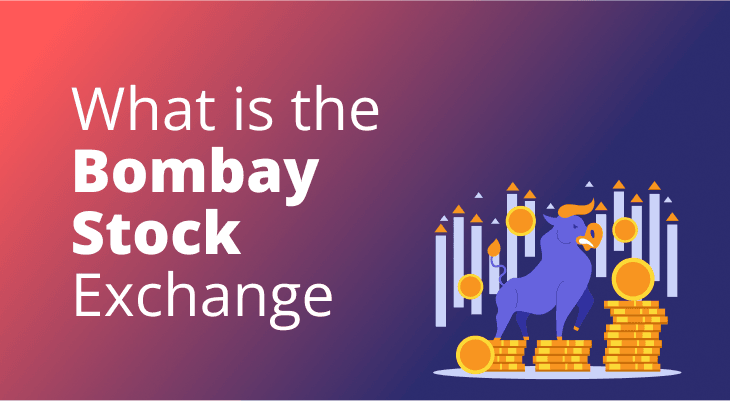
What is the Bombay Stock Exchange: Functions, Features & Benefits of the BSE
In India, there are two premier stock exchanges currently in operation - the Bombay Stock Exchange (BSE) and the National Stock Exchange (NSE). Both exchanges facilitate the purchase and sale of a wide range of securities such as equity shares, bonds, debentures, exchange-traded funds and derivative contracts.
Of these two, the Bombay Stock Exchange is the oldest stock exchange not only in India but the whole of the Asian continent. Throughout its rich history, the exchange has played a crucial role in the development of the Indian financial markets. Here’s everything you need to know about India’s first stock exchange, how it works and its various functions.
What is the Bombay Stock Exchange?
Established in 1875 in Dalal Street, Mumbai, the Bombay Stock Exchange or BSE is Asia’s first-ever stock exchange. It provides investors and other market participants with a platform to freely buy and sell financial instruments. Currently, the Bombay Stock Exchange has more than 5,200 companies listed on its platform with more entities getting included every year.
As of November 29, 2023, the total market capitalisation of the Bombay Stock Exchange touched an all-time high of $4 trillion. It took the exchange 10 years to double its total market cap of $1 trillion to $2 trillion. However, thanks to increased retail participation, it took only 6 years for it to double once again from $2 trillion to $4 trillion.
How Does the BSE Work?
Now that we’ve answered what BSE is, let’s take a look at how it works with the help of a hypothetical example.
Ever since the Bombay Stock Exchange migrated to a completely automated and electronic trading system - the BSE Online-Trading System (BOLT) - trading of securities on the exchange has been carried out electronically via its trading members (stockbrokers ).
Now, let’s say that you wish to purchase a stock of a company that’s listed on the Bombay Stock Exchange. You log into your stockbroker’s trading portal, who is a trading member of BSE, and place a buy order for the stock. The stockbroker sends the buy order to the exchange electronically.
The BSE’s automated electronic trading system matches your buy order with a corresponding sell order containing the same particulars such as price and quantity. If there’s a match, the exchange executes the trade and forwards the trade-related information to a clearing corporation. The clearing corporation then debits the requisite number of shares from the demat account of the seller and credits them to your demat account by the end of the T+1 settlement cycle.
The History of BSE
Although understanding what the BSE is is important, it is equally crucial for you to know the history behind the oldest stock exchange in Asia. Here’s a brief overview of how the Bombay Stock Exchange came into the picture.
The Bombay Stock Exchange started as a congregation of five stockbrokers as early as the 1850s. As the number of brokers grew, the congregation shifted their meetings to different places until they landed on Dalal Street, Mumbai in 1874. It was then that they decided to incorporate an entity known as The Native Share & Stock Brokers Association, which became the Bombay Stock Exchange later on.
Up until the introduction of the BSE Online-Trading System (BOLT) in 1995, trades in the exchange happened exclusively through the traditional open outcry system, where brokers would physically congregate together on a trading floor to buy and sell shares of companies. However, once BOLT was introduced, the open outcry system was slowly phased out. Currently, all the trades in the Bombay Stock Exchange happen electronically.
Advantages of Listing on the BSE
When a company gets listed on the Bombay Stock Exchange, it enjoys a plethora of different benefits. Let’s look at some of the key advantages.
Access To Capital
To get listed on the BSE, companies will have to issue their shares to the public via an IPO . This is a good avenue to raise fresh capital, which can be used to further its business objectives. Additionally, listed companies often find it easier to raise debt capital since it provides debt investors with confidence and a high level of transparency.
Better Visibility
As you know already, the Bombay Stock Exchange is the oldest and largest stock exchange in India. Additionally, the exchange also has a significant global presence, which companies can leverage to increase their visibility and brand awareness amongst the public.
Liquidity For Shareholders
Once a company is listed on the BSE, its shares can be freely traded between investors. This provides some much-needed liquidity for existing shareholders since they can exit the company by liquidating their holdings at any time.
Improved Valuation
Listed companies often enjoy significantly higher valuations compared to unlisted companies. This is primarily because the stock prices of listed companies are determined by market forces and not necessarily only by their fundamentals.
Easier Mergers And Acquisitions
Companies listed on the Bombay Stock Exchange generally find it easier to be a part of mergers and acquisitions. They can simply use their stock as a form of currency to enter into strategic partnerships with other companies.
What are the Different Market Segments Available on the BSE?
As an investor, you’ve seen what the Bombay Stock Exchange is. Now, let’s delve into the various market segments that you can trade on the exchange.
The market segments on the Bombay Stock Exchange can be broadly classified into two major categories - the cash market segment and the derivatives market segment. Each of these two primary categories can be sub-classified into several smaller segments. Here’s a quick overview of these segments.
Cash Market Segment
In the cash market segment, financial instruments that are bought are physically settled, meaning that they’re delivered to the demat accounts of the buyer. The cash market can be sub-classified into two types depending on the type of asset being bought or sold.
The first category is the equity cash market, where equity shares of companies are traded. The second category is the fixed-income and debt market, where a wide range of debt instruments such as debentures, bonds and government securities are traded on the exchange.
Derivatives Market Segment
In the derivatives market segment, derivative contracts such as futures and options are traded. These contracts are only physically settled if they’re held till the contract expiration date. Traders can avoid physical settlement by squaring off their open positions before the expiration date.
Similar to the cash market segment, the derivatives market can also be sub-classified into three types, namely, equity derivatives, currency derivatives and commodity derivatives. In the equity derivatives market, futures and options contracts with equity stocks as the underlying asset are traded. In the currency derivatives market, contracts with currency pairs as the underlying asset are traded. Finally, in the commodity derivatives market, contracts with commodities as the underlying asset are traded.
What are the Major Indices of the BSE?
The first-ever index created by the Bombay Stock Exchange was the Sensex. The index was launched in 1986 and comprises a list of 30 of the top companies listed on the exchange in terms of market capitalisation. Since the index features entities across multiple sectors and industries, it is often used by market participants to gain insights into how the stock market moves.
In addition to the Sensex, the BSE also provides a plethora of other broad-market and sector-specific indices. Let’s take a quick look at some of the major indices of the exchange.
S&P BSE SENSEX Next 50
S&P BSE MidCap
S&P BSE BANKEX
S&P BSE Services
S&P BSE PSU
S&P BSE India Manufacturing Index
Conclusion
You should now be aware of what the BSE is, how it works and the various benefits companies stand to gain by listing their shares on the exchange. Being the largest and oldest exchange in India, the contribution of the Bombay Stock Exchange to the development of the Indian financial markets has been nothing short of stellar. The exchange is in a constant endeavour to improve, innovate and regulate the Indian capital markets.
FAQ
What is the BSE?
BSE or Bombay Stock Exchange is India’s first-ever stock exchange. It provides a platform for investors to freely purchase and sell equity shares and other financial instruments electronically.
When was the Bombay Stock Exchange established?
The Bombay Stock Exchange was first established in 1875 in Dalal Street, Mumbai by Premchand Roychand, who was a cotton merchant.
Who is the Chairman of the Bombay Stock Exchange?
As of November 29, 2023, the chairman of the Bombay Stock Exchange is Shri S. S. Mundra and the Managing Director and CEO of the exchange is Shri Sundaraman Ramamurthy.
What is the role of the BSE?
The primary role of the Bombay Stock Exchange is to facilitate the purchase and sale of financial instruments between investors and other market participants. In addition to trade facilitation, the BSE also has other roles such as clearing and settlement of trades, investor education and dissemination of market data.
How many stocks are listed on the BSE?
As of November 29, 2023, there are around 5,287 companies currently listed on the Bombay Stock Exchange.


